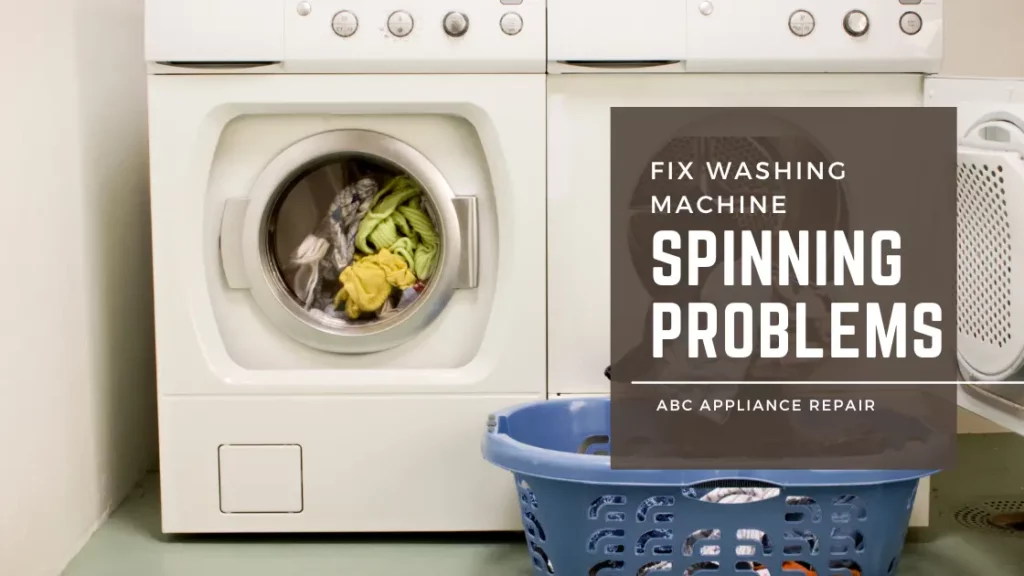Maintaining clean and fresh clothes relies heavily on a functional washing machine. However, when problems arise with its spinning function, it can be highly frustrating and disrupt your entire laundry routine.
In this comprehensive guide, we are here to assist you in troubleshooting and resolving the spinning problem in your washing machine. By following these step-by-step instructions, you’ll be able to diagnose and resolve the issue, ensuring your washing machine operates smoothly.
Understanding the Spinning Problem
Before diving into the solutions, it’s important to understand why spinning is crucial in a washing machine and recognize the signs of a spinning problem. When the spinning function is impaired, clothes may come out wet or dripping, and excess water may be left in the drum. If you can’t find the actual problem, you should definitly call for a washing machine repair expert in your area.
Potential causes of a spinning problem can vary from an unbalanced load, drive belt issues, motor problems, lid switch malfunction, to agitator issues. Each of these factors can disrupt the spinning cycle, and we’ll address them in detail.
Related Blog: Common Washer Machine Issues That Require Expert Help to Fix
Preparing for Repair
Before getting started with any repair work, it’s vital to prioritize safety. Remember to disconnect your washing machine from the power source and gather the necessary tools and materials. By taking these precautions, you can prevent accidents and ensure a smooth repair process.
Unbalanced Load Issues
An unbalanced load is a common reason for a washing machine’s spinning problem. It occurs when the laundry inside the drum is unevenly distributed, leading to an unstable spinning cycle. To resolve this issue, follow these steps:
Stop the cycle: If you notice an unbalanced load, pause the washing machine by pressing the appropriate button or turning the knob.
Rearrange the laundry: Open the door and rearrange the clothes inside, redistributing them evenly. Ensure that bulky items are evenly spread out.
Restart the washing machine: Close the door and restart the cycle. The machine should now operate with a balanced load, enabling proper spinning.
Drive Belt Troubleshooting
The drive belt is responsible for transmitting power from the motor to the drum. Over time, it can become worn, damaged, or broken, resulting in a spinning problem. Here’s how you can troubleshoot and replace a faulty drive belt:
Access the drive belt: Depending on your washing machine’s model, you may need to remove the back panel or top cover to access the drive belt.
Removing the old drive belt: Begin by inspecting the belt for any signs of damage, such as cracks or fraying. Loosen the tension and carefully detach the old belt from the pulleys.
Installing the new drive belt: Place the new belt onto the pulleys, ensuring proper alignment. Refer to the manufacturer’s diagram or instructions for guidance.
Testing the machine: Once the new drive belt is securely in place, reassemble the washing machine. Run a test cycle to verify that the spinning function is operating correctly.
Motor Problems

A malfunctioning motor can also contribute to a washing machine’s spinning problem. To troubleshoot motor-related issues, follow these steps:
Check for power supply issues: Ensure that the washing machine is properly connected to a power source and that the circuit breaker hasn’t tripped.
Inspect motor connections: Locate the motor and check the connections for any loose or disconnected wires. Reconnect them securely if needed.
Test motor continuity: Use a multimeter to check for continuity in the motor’s windings. If the motor fails the continuity test, it may need to be replaced.
Replace the motor: If the motor is beyond repair, you will need to replace it. Consult the manufacturer’s instructions or seek professional assistance for this task.
Lid Switch Malfunction
The lid switch plays a crucial role in the washing machine’s spinning cycle. It ensures that the machine operates only when the lid is securely closed. If the lid switch is faulty, the spinning function may not work correctly. Follow these steps to test and replace the lid switch if necessary:
Disable power to the machine: Unplug the washing machine or turn off the circuit breaker to ensure your safety during the repair process.
Locate and inspect the lid switch: Depending on your washing machine model, the lid switch can be found either beneath the lid or on the side of the machine’s housing. Inspect the switch for any signs of damage or wear.
Test the continuity of the lid switch: Use a multimeter to check if the lid switch has continuity when the lid is closed and if it loses continuity when the lid is open. If it fails either of these tests, it needs to be replaced.
Replace the lid switch: Remove the faulty lid switch and install a new one following the manufacturer’s instructions. Ensure proper alignment and secure connections.
Agitator Issues
Problems with the agitator can also affect the spinning function of a washing machine. The agitator is responsible for creating the motion that helps clean and spin the clothes. Here’s how you can address agitator-related issues:
Remove the agitator cap: Locate the cap on top of the agitator and pry it off using a flat-head screwdriver or by twisting it counterclockwise, depending on the model.
Inspect the agitator components: Examine the agitator for any broken or worn-out parts, such as agitator dogs or cogs. These components can prevent proper spinning and may need to be replaced.
Clean or replace the agitator parts: If the agitator parts are dirty or clogged, clean them thoroughly. If they are damaged, replace them with new ones, ensuring a proper fit.
Reassemble the agitator: Place the cleaned or replaced parts back into the agitator, ensuring they are correctly aligned. Replace the agitator cap securely.
Other Possible Causes
While unbalanced loads, drive belt issues, motor problems, lid switch malfunction, and agitator issues are common reasons for spinning problems, there are a few less common causes to consider as well. These include an overheating motor, a damaged transmission, or a control board malfunction. If you’ve exhausted the previous troubleshooting steps and the issue persists, it may be necessary to call a professional technician like ABC Appliance Repair in Charlotte area, if you live near Charlotte, for further diagnosis and repair.
Preventive Maintenance Tips
To keep your washing machine running smoothly and prevent future spinning problems, it’s important to follow these maintenance tips:
1. Clean the drum regularly: Remove any lint, debris, or residues from the drum to ensure proper spinning and avoid clogs.
2. Check and clean the filter: Refer to your washing machine’s manual to locate and clean the filter regularly. This will prevent blockages and maintain optimal performance.
3. Avoid overloading: Follow the manufacturer’s recommended load capacity to prevent unbalanced loads and strain on the machine.
4. Balance the load: Distribute the laundry evenly inside the drum to maintain a balanced load during the spinning cycle.
5. Address issues promptly: If you notice any signs of a spinning problem, address them promptly to prevent further damage and costly repairs.
FAQs
There could be several reasons, such as an unbalanced load, drive belt issues, motor problems, lid switch malfunction, or agitator problems.
Yes, an unbalanced load can disrupt the spinning cycle of a washing machine.
You can test the continuity of the lid switch using a multimeter. If it fails the continuity test when the lid is closed or open, it may be faulty.
Signs of a worn-out drive belt include cracks, fraying, or loss of tension. It may also lead to a spinning problem in the washing machine.
If you have followed the troubleshooting steps outlined in the guide and the spinning problem persists, it may be necessary to seek professional help for further diagnosis and repair.
Conclusion
A washing machine with a spinning problem can disrupt your laundry routine and leave clothes improperly cleaned. By following the troubleshooting steps outlined in this guide, you can diagnose and fix common spinning issues. Remember to prioritize safety, gather the necessary tools, and consult the manufacturer’s instructions when performing repairs. Regular preventive maintenance will also help keep your washing machine running smoothly, ensuring clean and fresh laundry every time.







